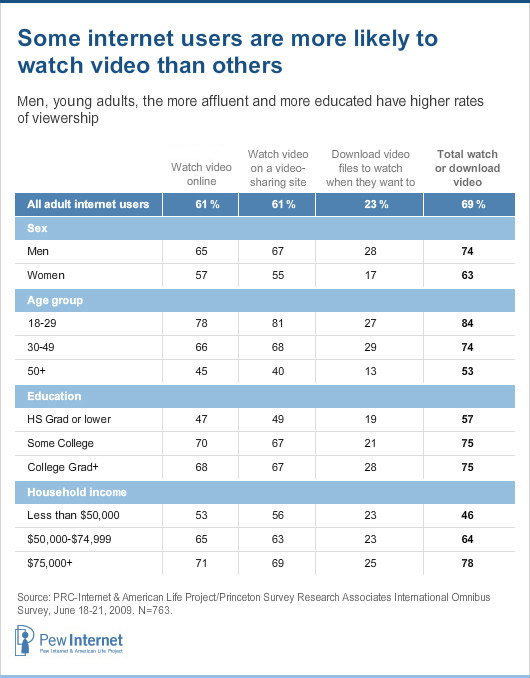Who is watching and downloading online video?
Seven in ten adult internet users (69%), or roughly half of all U.S. adults (52%) have used the internet to watch or download video.1 That figure includes internet users who say they do at least one of the following:
- Watch videos online, including short video clips, television shows, or movies (61% of adult internet users)
- Watch a video on a video-sharing site like YouTube or Google Video (61% of adult internet users)
- Download video files onto their computer so they can play them at any time they want (23% of adult internet users)
Of these three activities, the most notable change involves the exploding popularity of video-sharing sites like YouTube or Google Video. The percent of adult internet users who watch video on these sites has grown from 33% in December 2006 to 61% in the current survey.2
Which internet users are most likely to be watching or downloading video? Overall, men, young adults, the more affluent and the more educated are most likely to engage in the three activities that define our group of video watchers (see table below). Broadband users are also particularly likely to watch or download online vide; 75% of adults with home broadband access are online video watchers. Among the entire population of video watchers, nine in ten (89%) have broadband at home.
Among these online video consumers, 8% have connected their computer to their television so they can watch online video on a television screen. This represents 5% of all adult internet users, which is slightly lower than the 8% of adult internet users who were watching online video on their television screens in an April 2009 Pew Internet survey.
One in ten video watchers (10%), or 7% of adults internet users, have paid to watch or download a video online. In 2007, 4% of internet users had paid to access or download video online.

What kinds of video are online adults watching?
Almost every type of video asked about in the survey has grown in popularity over the past two years, and online video watchers are consuming a mix of entertaining and informational content. The most popular online videos today are comedy or humorous videos, a change from 2007 when the most popular online videos were news videos. Over the past two years, comedy video viewership has grown more than any other type of video asked about in the survey, and today half of all online adults (50%) have watched a comedy video online.
Since 2007, educational videos have also experienced considerable growth, from 22% of online adults watching this type of video in 2007 to 38% watching in 2009. Over the same time period, online viewership of both television shows/movies and political videos has doubled, while online news videos have experienced relatively small growth in popularity (see table below).

As was the case in 2007, younger adults are clearly drawn more than older adults to entertainment content, such as funny videos, music videos, movies or TV shows, sports video and adult content. For instance, among online video watchers, almost all 18-29 year-olds (93%) have watched a comedy video online, while the same is true of just 74% of 30-49 year-old video watchers and 52% of video watchers age 50 and older. Older video watchers, in contrast, are more likely than 18-29 year-olds to spend their time watching news videos and educational videos. Surprisingly, political videos have fairly consistent appeal across online video watchers of all ages.

As was the case in previous Pew Internet surveys, male online video watchers consume sports videos (47% v. 12%), adult videos (18% v. 2%), and animation/cartoons (38% v. 25%) at higher rates than female video watchers. News video is watched more often by college graduates than by video watchers with lower educational attainment (73% v. 57%).
While non-white internet users are no more or less likely than white internet users to watch video online, they are more likely than white adults to be drawn to entertainment content. Among online video watchers, nonwhites are more likely than whites to watch movies or TV shows online (56% of non-white video watchers v. 44% of white video watchers), music videos (60% v. 42%), and animation/cartoons (41% v. 29%).
Among the lowest income respondents, those earning less than $30,000 a year, music videos and animation/cartoons are particularly popular.


